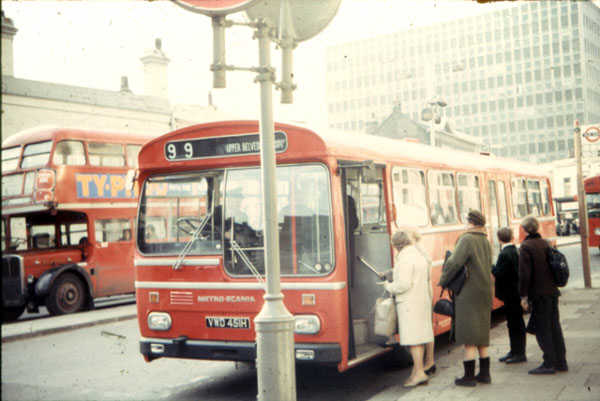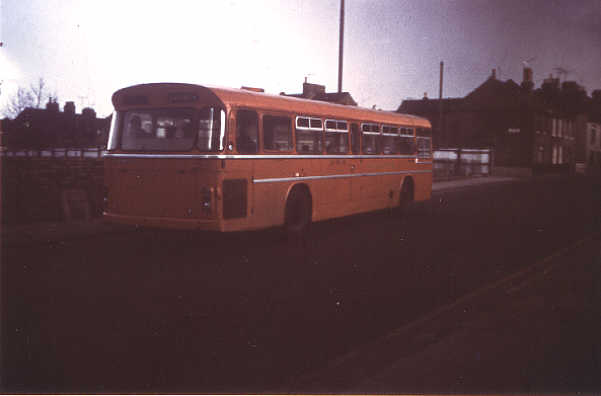

| Metro Scania VWD 451H
Service 99. Woolwich, Bostal Hill, Upper Belvedere, Erith. London Transport carried out trials on service 99 with this bus in 1970. Seen at Woolwich, General Gordon Place. Outside Woolwich Arsenal railway station. March 1970 Photograph John King |
| This bus was on trial for some time on service 99 in early 1970. It
was fast, smooth and pulled up Bostal Hill, which some of the older buses
had trouble with. Unfortunately after the trials were over we saw no more
of this bus in the area.
Four Metro Scania were bought for the super bus service in Stevenage in 1972 and designated MS. (MS 1-4. GPB 19/20J. JPH 68/69K.) Three more were brought in from Hants and Dorset in 1973 for use on the same service, (MS 5-7. AOU 108 - 110J) Also six buses designated MS (MS 1 - 6. PGC 201 - 206L) were used on service S2 along with LS. (VWD 451H was not amongst any of them) but no more were seen in South East London. For a picture of MS on superbus and a preserved vehicle see:- http://www.ukip.co.uk/~ampyx//ms.html |

| This picture is taken in Erith Road, Upper Belvedere. (Between Picardy
Road and Brook Street). March 1970
Photograph John King |
| A red Metro Scania was seen in Manchester. It had a large SELNEC logo
sticker on the side. SELNEC was the interim bus company that preceded Greater
Manchester Buses, made up of all the existing companies - mostly owned
by the local town councils. SELNEC stood for South East Lancashire North
East Cheshire. The give-away was the letters AM (for Plumstead Garage)
still painted in the place next to where the metal number tag went at the
side of the bus towards the front. The vehicle (presumably VWD 451H) was
probably a company demonstrator and it was being loaned out to various
bus companies.
VWD 451H was being tried out by the West Midlands PTE, in 1972, they were pleased with the bus as they bought one of their own (4242) in January 1973. 'H' registration was from 1 August 1969, so London Transport may have been the first to try this bus out. |

| VWD 451H in Plumstead High Street, near Heverham Road. The wasteground
on the left of the road is now the Dick Neave House development.
Photograph. John King. |
| VWD 451H, was one of two demonstrators built in 1969 by MCW in Birmingham,
registered VWD 451H and VWD 452H.
It is extremely likely that one of these* was loaned to Newport Transport for demonstration purposes. Newport bought a large batch of 44 Scania BR111MH with MCW B40D bodywork between 1971 and 1972. Leicester had one, of the demonstrators, VWD 452H on loan from 19/11/69 for a while and then again from 18/02/70. Scania BR111/MCW Metro Scania. Built in Sweden/Birmingham from 1969
until 1973. The model was a semi integral vehicle based on the Scania BR110/1
and CR110 chassis.
Since the prototype was an MCW demonstrator (made in Birmingham) it would have carried a 'local' registration number, hence the Warwickshire index. MCW stands for Metro Cammell Weymann, and this was an amalgam of two company's, Weymann and Metro-Cammell which had previously been Cammell-Laird just to complicate matters! Scania-Vabis is the full, correct name for the Swedish commercial vehicle manufacturer who also make Saab cars. Metro-Scania was just a name coined by MCW to reflect the combination of Scania running units with bodywork by MCW. Several minor, but unspecified modifications were made to VWD prior to service with LT to make it suitable for service in London and in order to gain experience by operating it in comparison with MB types. LT was its first port of call. It is often quoted as being used on a three month trial when in fact it entered service on the Monday following conversion of routes 99/122a on 24 January 1970 and was gone by the end of March. It ran on route 99 only during weekdays, and not at all at weekends (Sunday workings were from Abbey Wood using RMs. The central exit was cordoned off for the first couple of weeks of operation, and when finally put into use, had leafs which opened outwards either side of the doorway, rather than the usual jacknife arrangement. The bell-push was a continuous plastic strip along the entire length of the nearside, and their were 40 seats with provision for 20 standing. *Paul Harley says that one of these two buses was definitely loaned to Newport Transport Many thanks to Anthony Wilson and Steve Thoroughgood for gathering much of the information used on this page. |
This page was designed and is maintained
by Toby and John King, I would accept any comments or questions See
Index Page